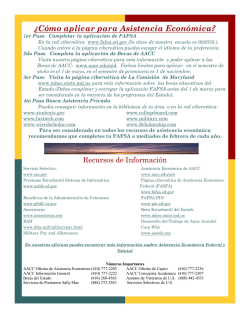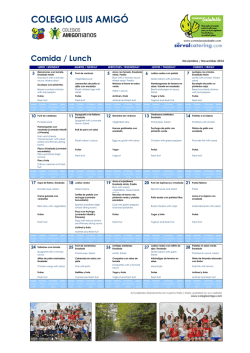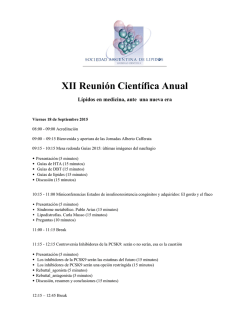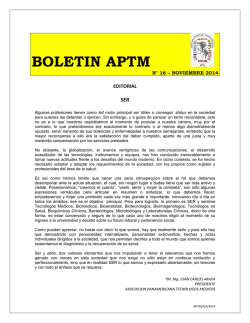
Total lipids
TOTAL LIPIDS Total lipids Sulfo-phospho vainilline. Colorimetric Quantitative determination of total lipids IVD 6. Store at 2-8ºC PRINCIPLE OF THE METHOD Unsaturated lipids react with sulphuric acid to form carbonium ions. In a second step the carbonium ions react with phosphovainilline to give a pink colour. The intensity of the color formed is proportional to the total lipids concentration in the sample1,2. CLINICAL SIGNIFICANCE The lipids are organic compounds whose more important function is the one to act like fuel. They have an extraordinary yield, favored by the possibility of storing itself in remarkable amounts like fatty weave. Other functions: they are constituent of biological membranes, form protective fatty structures of the internal organs; provide important compounds in the formation with diverse hormones. Great part of the interest in the study of the increase of these compounds must to the connection between hyperlipemia and arteriosclerosis, diabetes and cardiac disease5,6. Clinical diagnosis should not be made on a single test result; it should integrate clinical and other laboratory data. REAGENTS R Phosphovainilline TOTAL LIPIDS CAL Total Lipids aqueous primary standard 750 mg/dL PRECAUTIONS Corrosive (C):R35:Causes severe burns. PREPARATION Reagent and calibrator are ready to use. STORAGE AND STABILITY All the components of the kit are stable until the expiration date on the label when stored tightly closed at 2-8ºC protected from light and contaminations prevented during their use. Do not use reagents over the expiration date. Signs of reagent deterioration: Presence of particles and turbidity. Blank absorbance (A) at 520 nm 0,32. ADDITIONAL EQUIPMENT Spectrophotometer or colorimeter measuring at 520. Matched cuvettes 1,0 cm light path. General laboratory equipment. SAMPLES Serum or plasma1,2 : Stability of the sample: Total lipids are stable 24 h at room temperature (15-25ºC) or 3 days at 2-8ºC. PROCEDURE 1. Assay conditions: Wavelength: . . . . . . . . . . . . . . . . . . . 520 (490-550) nm Cuvette: . . . . . . . . . . . . . . . . . . . . . . . . . .1 cm light path Temperature: . . . . . . . . . . . . . . . . . . . . . . . . . . . . . 37ºC 2. Adjust the instrument to zero with distilled water. 3. Pipette into a glass tubes: H2SO4 (mL) Standard(Note 1,2) (L) Sample (L) 4. 5. Sample 2,5 -100 Shake thoroughly using a mechanical stirrer. Incubate for 10 minutes in a boiling water bath (100ºC). BSIS27-I 20/02/15 CALCULATIONS (A) Sample (A)Blank x 750 (Standard conc.) = mg/dL total lipids in the sample (A) S tan dard (A)Blank QUALITY CONTROL Control sera are recommended to monitor the performance of assay procedures: SPINTROL H Normal and Pathologic (Ref. 1002120 and 1002210). If control values are found outside the defined range, check the instrument, reagents and calibrator for problems. Each laboratory should establish its own Quality Control scheme and corrective actions if controls do not meet the acceptable tolerances. REFERENCE VALUES1 Serum or plasma: 450 – 800 mg/dL These values are for orientation purpose; each laboratory should establish its own reference range. 235 mmol/L Needed reagent but not provided: Sulphuric acid p.a. (H2SO4) Standard 2,5 100 -- Cool in iced water and transfer into a cuvette: Blank Standard Sample R (mL) 1,0 1,0 1,0 --50 Sample Acid digest (L) -50 -Standard Acid digest (L) 7. Shake thoroughly using a mechanical stirrer. 8. Incubate for 15 minutes at 37ºC. 9. Read the absorbance (A) of the samples and standard, against the Blank. The colour is stable for at least 1 hour. PERFORMANCE CHARACTERISTICS Measuring range: From detection limit of 7,7 mg/dL to linearity limit of 1500 mg/dL. If the results obtained were greater than linearity limit, dilute the sample 1/2 with NaCl 9 g/L and multiply the result by 2. Precision: Intra-assay (n=20) Inter-assay (n=20) Mean (mg/dL) 555 919 553 919 SD 15,9 6,47 7,62 5,87 CV (%) 2,87 0,70 1,78 0,63 Sensitivity: 1 mg/dL = 0,00066 A. Accuracy: Results obtained using SPINREACT reagents (y) did not show systematic differences when compared with other commercial reagents (x). The results obtained using 50 samples were the following: Correlation coefficient (r): 0,984 Regression equation: y=0,967x + 24,08 The results of the performance characteristics depend on the analyzer used. INTERFERENCES A list of drugs and other interfering substances with total lipids determination has been reported by Young et. al3,4. NOTES 1. TOTAL LIPIDS CAL: Proceed carefully with this product because due its nature it can get contamined easily. 2. Calibration with the aqueous standard may cause a systematic error in automatic procedures. In these cases, it is recommended to use a serum Calibrator. 3. Use clean disposable pipette tips for its dispensation. 4. SPINREACT has instruction sheets for several automatic analyzers. Instructions for many of them are available on request. BIBLIOGRAPHY 1. 2. 3. 4. 5. 6. Kaplan A et al. Lipids. Clin Chem The C.V. Mosby Co. St Louis. Toronto. Princeton 1984; 918-919. Cottet M.J. et al. Dosage des lipides sériques par la méthode sulfo-phosphovanillique (1) de E Chabrol et R. Charonnat. Académie National de Médicine. 1965;149: 331-338. Young DS. Effects of drugs on Clinical Lab. Tests, 4th ed AACC Press, 1995. Young DS. Effects of disease on Clinical Lab. Tests, 4th ed AACC 2001. Burtis A et al. Tietz Textbook of Clinical Chemistry, 3rd ed AACC 1999. Tietz N W et al. Clinical Guide to Laboratory Tests, 3rd ed AACC 1995. PACKAGING Ref: 1001270 Cont. R: 2x150 mL, CAL: 1x5 mL SPINREACT,S.A./S.A.U. Ctra.Santa Coloma, 7 E-17176 SANT ESTEVE DE BAS (GI) SPAIN Tel. +34 972 69 08 00 Fax +34 972 69 00 99. e-mail: [email protected] TOTAL LIPIDS Lipidos totales Sulfo-fosfo vainillina. Colorimétrico Determinación cuantitativa de lípidos totales IVD Conservar a 2-8ºC PRINCIPIO DEL METODO Los lípidos insaturados reaccionan con el ácido sulfúrico en caliente con formación de iones carbonio. En una segunda etapa, éstos, en presencia de fosfovainillina dan una coloración rosada. La intensidad del color formado es proporcional a la concentración de lípidos totales presente en la muestra ensayada1,2. SIGNIFICADO CLINICO Los lípidos son compuestos orgánicos cuya función más importante es la de actuar como combustible. Poseen un extraordinario rendimiento, favorecido por la posibilidad de almacenarse en notables cantidades como tejido adiposo. Otras funciones: son constituyentes de las membranas biológicas, forman estructuras adiposas protectoras de los órganos internos, y proveen compuestos importantes en la formación de diversas hormonas. Gran parte del interés en el estudio del aumento de estos compuestos se debe a la conexión entre hiperlipemia y arteriosclerosis, diabetes y enfermedad cardiaca5,6. El diagnostico clínico debe realizarse teniendo en cuenta todos los datos clínicos y de laboratorio. REACTIVOS R Fosfovainillina TOTAL LIPIDS CAL Patrón primario acuoso de Lípidos Totales 750 mg/dL 235 mmol/L Reactivo necesario no suministrado: Ácido sulfúrico p.a. (SO4 H2) PRECAUCIONES Corrosivo (C): R35: Provoca quemaduras graves. PREPARACION Reactivo y calibrador listos para su uso. CONSERVACION Y ESTABILIDAD Todos los componentes del kit son estables, hasta la fecha de caducidad indicada en la etiqueta del vial, cuando se mantienen los viales bien cerrados a 2-8ºC, protegidos de la luz y se evita su contaminación. No usar reactivos fuera de la fecha indicada. Indicadores de deterioro de los reactivos: - Presencia de partículas y turbidez. - Absorbancia (A) del Blanco a 520 nm 0,32. MATERIAL ADICIONAL - Espectrofotómetro o analizador para lecturas a 520 nm. - Cubetas de 1,0 cm de paso de luz. - Equipamiento habitual de laboratorio. MUESTRAS Suero o plasma1,2. Estabilidad de la muestra: Los lípidos totales son estables 24 h a temperatura ambiente (15-25ºC) o 3 días a 2-8ºC. PROCEDIMIENTO 1. Condiciones del ensayo: Longitud de onda: . . . . . . . . . . . . . . . 520 (490-550) nm Cubeta: . . . . . . . . . . . . . . . . . . . . . . . .1 cm paso de luz Temperatura: . . . . . . . . . . . . . . . . . . . . . . . . . . . . . 37ºC 2. Ajustar el espectrofotómetro a cero frente a agua destilada. 3. CALCULOS (A) Muestra (A)Blanco x 750 (Conc. Patrón.) =mg/dL de lípidos totales en la muestra (A) Patrón (A)Blanco CONTROL DE CALIDAD Es conveniente analizar junto con las muestras sueros control valorados: SPINTROL H Normal y Patológico (Ref. 1002120 y 1002210). Si los valores hallados se encuentran fuera del rango de tolerancia, revisar el instrumento, los reactivos y el calibrador. Cada laboratorio debe disponer su propio Control de Calidad y establecer correcciones en el caso de que los controles no cumplan con las tolerancias. VALORES DE REFERENCIA1 Suero o plasma: 450 – 800 mg/dL Estos valores son orientativos. Es recomendable que cada laboratorio establezca sus propios valores de referencia. CARACTERISTICAS DEL METODO Rango de medida: Desde el limite de detección de 7,7 mg/dL hasta el limite de linealidad de 1500 mg/dL. Si la concentración de la muestra es superior al limite de linealidad, diluir 1/2 con ClNa 9 g/L y multiplicar el resultado final por 2. Precisión: Intraserie (n= 20) Interserie (n= 20) Media (mg/dL) 555 919 553 919 SD 15,9 6,47 7,62 5,87 CV (%) 2,87 0,70 1,78 0,63 Sensibilidad analítica: 1 mg/dL = 0,00066 A. Exactitud: Los reactivos SPINREACT (y) no muestran diferencias sistemáticas significativas cuando se comparan con otros reactivos comerciales (x). Los resultados obtenidos con 50 muestras fueron los siguientes: Coeficiente de correlación (r): 0,984 Ecuación de la recta de regresión: y=0,967x + 24,08 Las características del método pueden variar según el analizador utilizado. INTERFERENCIAS Se han descrito varias drogas y otras substancias que interfieren en la determinación de los lípidos totales3,4. NOTAS 1. TOTAL LIPIDS CAL: Debido a la naturaleza del producto, es aconsejable tratarlo con sumo cuidado ya que se puede contaminar con facilidad. 2. La calibración con el Patrón acuoso puede dar lugar a errores sistemáticos en métodos automáticos. En este caso, se recomienda utilizar calibradores séricos. 3. Usar puntas de pipeta desechables limpias para su dispensación. 4. SPINREACT dispone de instrucciones detalladas para la aplicación de este reactivo en distintos analizadores. BIBLIOGRAFIA 1. 2. Pipetear en tubos de ensayo: SO4 H2 (mL) Patrón (Nota1,2) (L) Muestra (L) 4. 5. 6. 7. 8. 9. Patrón 2,5 100 -- Muestra 2,5 -100 Mezclar enérgicamente con ayuda de un agitador mecánico. Incubar 10 minutos en un baño de agua hirviendo (100ºC). Enfriar en baño de agua fría y dosificar en cubetas: BSIS27-E 20/02/15 Blanco Patrón Muestra R (mL) 1,0 1,0 1,0 --50 Hidrolizado muestra (L) -50 -Hidrolizado Patrón (L) Mezclar enérgicamente con ayuda de un agitador mecánico. Incubar 15 minutos a 37ºC. Leer la absorbancia (A) del patrón y la muestra, frente al Blanco de reactivo. El color es estable como mínimo 1 hora. 3. 4. 5. 6. Kaplan A et al. Lipids. Clin Chem The C.V. Mosby Co. St Louis. Toronto. Princeton 1984: 918-919. Cottet M.J. et al. Dosage des lipides sériques par la méthode sulfo-phosphovanillique (1) de E Chabrol et R. Charonnat. Académie National de Médicine. 1965; 149: 331-338. Young DS. Effects of drugs on Clinical Lab. Tests, 4th ed AACC Press, 1995. Young DS. Effects of disease on Clinical Lab. Tests, 4th ed AACC 2001. Burtis A et al. Tietz Textbook of Clinical Chemistry, 3rd ed AACC 1999. Tietz N W et al. Clinical Guide to Laboratory Tests, 3rd ed AACC 1995. PRESENTACION Ref: 1001270 Cont. R: 2x150 mL, CAL: 1x5 mL SPINREACT,S.A./S.A.U. Ctra.Santa Coloma, 7 E-17176 SANT ESTEVE DE BAS (GI) SPAIN Tel. +34 972 69 08 00 Fax +34 972 69 00 99. e-mail: [email protected]
© Copyright 2026




